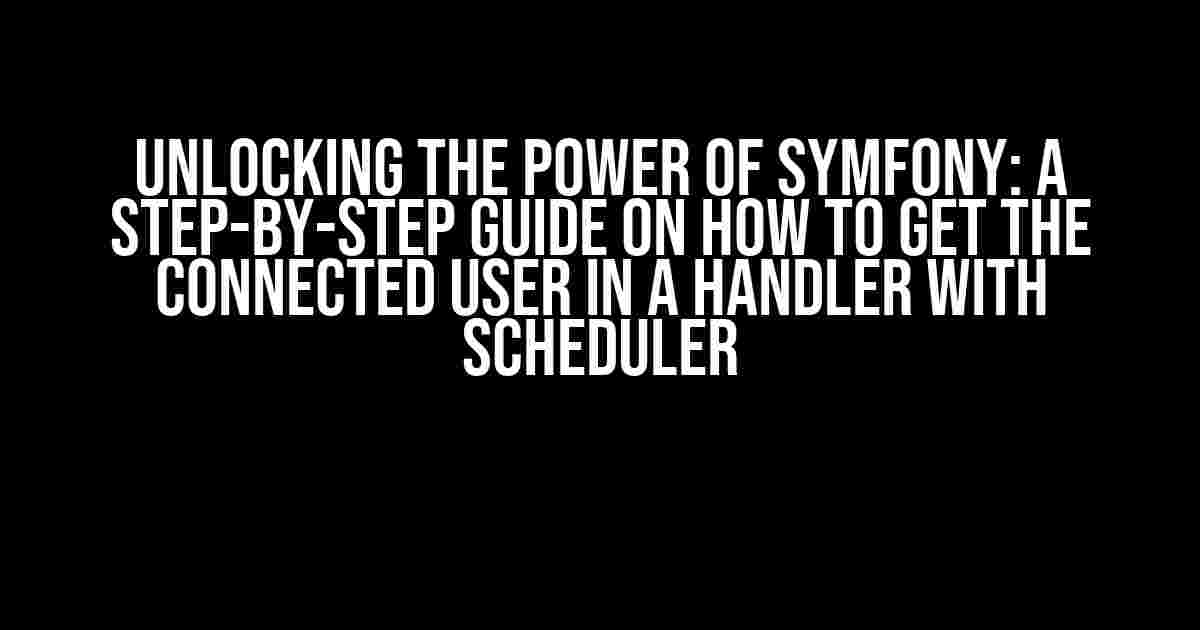Are you tired of struggling to get the connected user in a handler with Scheduler in Symfony? Look no further! In this comprehensive guide, we’ll take you by the hand and walk you through the process of retrieving the connected user in a handler with Scheduler in Symfony. By the end of this article, you’ll be a master of Symfony’s Scheduler component and be able to effortlessly retrieve the connected user in a handler.
Why Do I Need to Get the Connected User in a Handler with Scheduler?
Before we dive into the tutorial, it’s essential to understand the importance of getting the connected user in a handler with Scheduler. In many cases, you’ll need to perform tasks specific to the logged-in user, such as sending personalized notifications or updating their profile information. Without access to the connected user, you’ll be limited in what you can accomplish.
In addition, getting the connected user in a handler with Scheduler allows you to:
- Implement user-specific logic in your scheduled tasks
- Personalize the user experience with targeted notifications and updates
- Increase security by ensuring that only authorized users can access sensitive data
Step 1: Configure the Scheduler Component
Before you can get the connected user in a handler with Scheduler, you need to configure the Scheduler component in your Symfony project. Follow these steps:
- Install the Scheduler bundle by running the following command in your terminal:
- In your `config/bundles.php` file, add the following line to enable the Scheduler bundle:
- In your `config/packages/scheduler.yaml` file, configure the Scheduler component:
composer require symfony/scheduler-bundle
return [ ... Symfony\Component\Scheduler\Bundle\SchedulerBundle::class => ['all' => true], ];
scheduler:
dbal:
connection: doctrine.dbal.default_connection
Step 2: Create a Handler for Your Scheduled Task
Next, create a handler for your scheduled task that will retrieve the connected user. In your `src/Handler` directory, create a new file called `UserAwareHandler.php`:
<?php
namespace App\Handler;
use Symfony\Component\Security\Core\Authentication\Token\TokenInterface;
use Symfony\Component\Security\Core\Security;
class UserAwareHandler
{
private $security;
public function __construct(Security $security)
{
$this->security = $security;
}
public function handle()
{
// Get the connected user
$user = $this->security->getUser();
// Perform task specific to the connected user
// ...
}
}
In this example, we’ve created a `UserAwareHandler` class that takes a `Security` object in its constructor. This object provides access to the current user token, which we can use to retrieve the connected user.
Step 3: Get the Connected User in the Handler
Now that we have our `UserAwareHandler` class, let’s modify it to retrieve the connected user:
<?php
namespace App\Handler;
use Symfony\Component\Security\Core\Authentication\Token\TokenInterface;
use Symfony\Component\Security\Core\Security;
class UserAwareHandler
{
private $security;
public function __construct(Security $security)
{
$this->security = $security;
}
public function handle()
{
// Get the current user token
$token = $this->security->getToken();
// Check if the token is valid
if (!$token instanceof TokenInterface) {
throw new \RuntimeException('No authenticated user found');
}
// Get the connected user
$user = $token->getUser();
// Perform task specific to the connected user
// ...
}
}
In this modified version, we first get the current user token using the `getToken()` method. We then check if the token is valid by verifying that it’s an instance of `TokenInterface`. Finally, we retrieve the connected user by calling `getUser()` on the token.
Step 4: Schedule the Task with the Scheduler Component
Now that we have our `UserAwareHandler` class, let’s schedule the task with the Scheduler component:
<?php
namespace App\Controller;
use Symfony\Component\HttpFoundation\Response;
use Symfony\Component\Scheduler\Scheduler;
use App\Handler\UserAwareHandler;
class ScheduledTaskController extends Controller
{
public function scheduleTask(Scheduler $scheduler)
{
$handler = new UserAwareHandler($this->get('security.helper'));
$scheduler->add(new \Symfony\Component\Scheduler\Task('my_task', $handler));
return new Response('Task scheduled successfully');
}
}
In this example, we’ve created a `ScheduledTaskController` class that uses the `Scheduler` component to schedule a task. We create an instance of our `UserAwareHandler` class, passing the `Security` object to its constructor. We then add the task to the scheduler using the `add()` method.
Conclusion
And that’s it! You’ve successfully implemented a handler that retrieves the connected user in a scheduled task with Symfony’s Scheduler component. By following these steps, you can now perform tasks specific to the logged-in user, personalizing their experience and increasing security.
Remember, getting the connected user in a handler with Scheduler is just the beginning. The possibilities are endless, and it’s up to you to unlock the full potential of Symfony’s Scheduler component.
| Handler | Description |
|---|---|
| UserAwareHandler | A handler that retrieves the connected user and performs tasks specific to them |
We hope this article has been informative and helpful. If you have any questions or need further assistance, please don’t hesitate to ask.
Here are 5 FAQs about “How to get the connected user in a handler with Scheduler in Symfony”:
Frequently Asked Question
Ever wondered how to get the connected user in a handler with Scheduler in Symfony? You’re not alone! Here are some answers to the most frequently asked questions on this topic.
Q1: How do I get the current user in a command handler with Scheduler in Symfony?
You can inject the `TokenStorageInterface` into your command handler and use it to get the current user. Here’s an example: `private $tokenStorage; public function __construct(TokenStorageInterface $tokenStorage) { $this->tokenStorage = $tokenStorage; }`
Q2: What if I want to get the user in a scheduled task with Symfony?
In a scheduled task, you won’t have access to the Request object, so you can’t use the `TokenStorageInterface`. Instead, you can use the `security.token_storage` service and inject it into your task. Then, you can use it to get the current user.
Q3: How do I inject the TokenStorageInterface into my command handler?
You can inject the `TokenStorageInterface` into your command handler by adding it as a constructor argument. Then, in your `services.yml` file, you need to configure the service to pass the `token_storage` service as an argument.
Q4: What if I want to get the user in a listener with Scheduler in Symfony?
In a listener, you can inject the `TokenStorageInterface` just like in a command handler. Then, you can use it to get the current user. If you’re listening to an event, you can also get the user from the event object if it’s available.
Q5: Are there any security considerations when getting the connected user in a handler with Scheduler in Symfony?
Yes, there are! When getting the connected user in a handler with Scheduler, make sure you’re aware of the security implications. For example, if you’re using a queued job, the user may not be the same when the job is executed. Always validate the user and ensure you’re authorized to perform the action.


